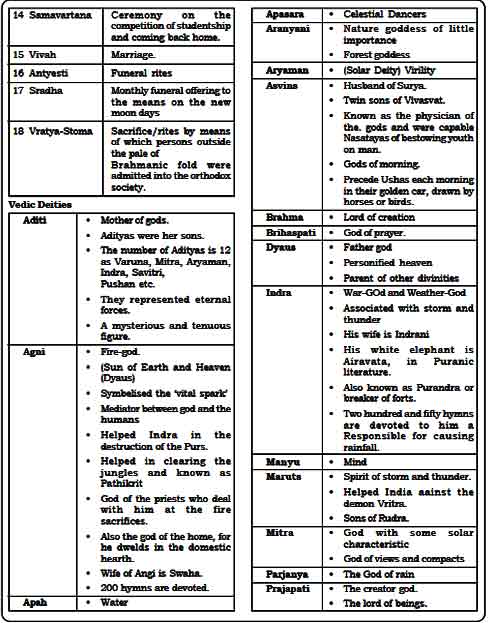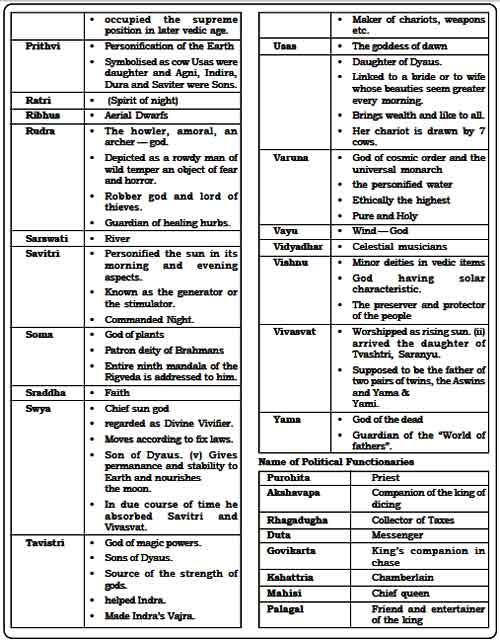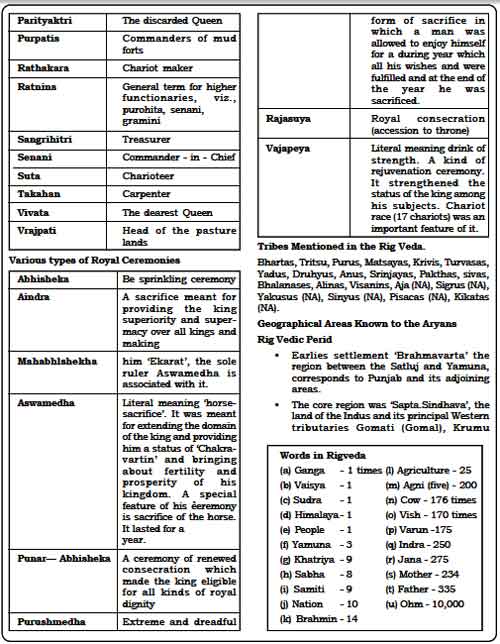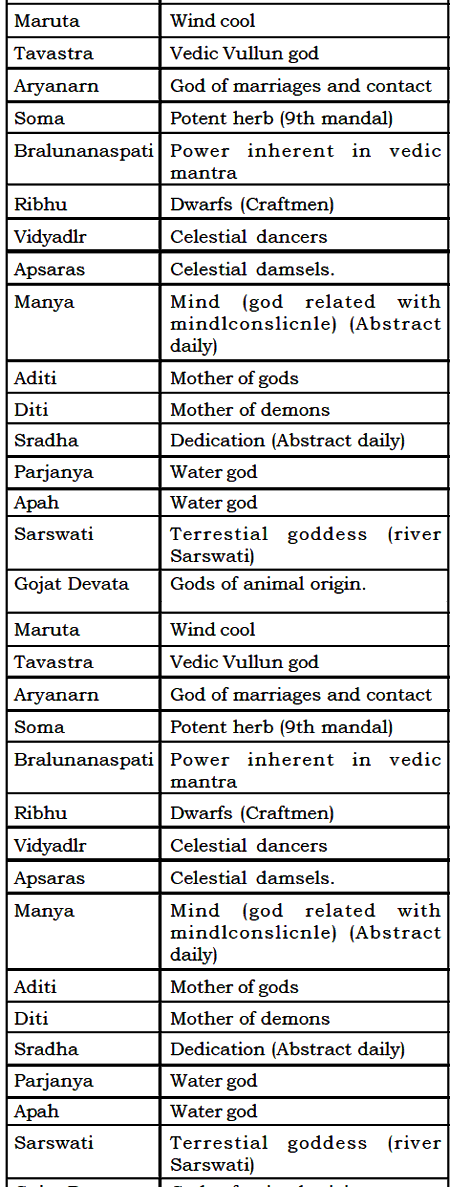(HOT) UPSC Current Affairs 2025 PDF
NEW! The Gist (NOV-2025) | E-BOOKS
(IGP) IAS Pre: GS - Indian History - Ancient India : The Vedic (Part - 1)
Ancient India
The Vedic (Part -1)
Rigvedic Period - l500-l000B.C
Later Vedic Period - 1000-600B.C
VEDIC PERIOD (IMPORTANT TERMS)
- Akratuh — People who had no faith in rituals.
- Anas — People who didn’t have prominent nose
- Apah — Water
- Brahmin — Rituals
- Dam - House
- Dunitri — daughter
- Gana - Tribal militia
- Gavisti — war
- Godhara — guest
- Godhuli—evening
- Gomat — a wealthy person
- Gopa (Janasya) — the ruler
- Gorasa-milk
- Gosthi — meeting
- Gotra- Cow pen
- Gvayuti — measurement of distance
- Mridhvaka — who were not adept in Vedic language
- Panch Char Sanyah — Five wandering tribes.
- Pani—people having cattle wealth (traders)
- Parjanya — cloud
- Purodasa — Materials used in Yajana
- Rayi — Cattle wealth
- Sadam - House
- Sala — House
- Sardha — Tribal militia
- Sisandeva—Wroshippers of phallus symbol.
- Vayadh — Costumes of a bride.
- Vesmin — House
- Vrata — people who hadnot a well established marriage system or who had incestuous relation.
- Vrata - Tribal militia
Vedic Geography:
| Adhavaryn | Yajurveda |
| Anandaka | Sadania |
| Brahma | Atharva Veda |
| Champaran | Champararanya |
| Chenab | Askini |
| Delhi | Indraprastha |
| Deobanda | Dritvan |
| Ghaghar | Drisdvasti |
| Hakra | Sarswati |
| Haryn | Saryn |
| Himalaya | Himvanta |
| Hota | Rigveda |
| Indus | Sindhu |
| Jhelum | Vilasta |
| Kabul | Kubha |
| Magadha | Kikatvan |
| Mithila | Videh |
| Ravi, | Parusani |
| Ritual Priests | Vedas |
| Saran | Nairnisheranya |
| Sutlej | Satudri |
| ‘Udgata | Sarnveda |
| Vyas | Vipasa |
Click here to download full Chapter
DOWNLOAD UPSC MAINS HISTORY 11 YEARS SOLVED PAPERS PDF
DOWNLOAD UPSC MAINS HISTORY 10 Years Categorised PAPERS
Study Noted for UPSC MAINS HISTORY Optional
Vedas and their branches:
| Vedas | Branches |
| Rigveda | Sakal, Vaskal, Asavala, Yan, Sakhayan and mandukeya |
| Samveda | Kauthum and Ranayaniaya |
| Yajurveda | Madhyandin and Kanva |
| Athar Veda | Paiplad and Saunak |
Rigveda:
Mandalas — Poets/Drasta
- Mandla - Gritsamada
- Mandla — Viswamiitra (Mandalas from, II to VII are called Family Text.)
- Mandla - Vamdeo
- Mandla — Atri
- Mandla— Bharadvaj
- Mandla —. Vasistha
- Mandla — Kand & Angirasa
The Word Arya means civilized one.
1 & 10 Mandalas were added later on.
References & Evidences,
| 1 | Origin of Indian music | Sam Veda |
| 2 | Mention of the word ‘Sudra' | Rig Veda (10th Mandala) |
| 3 | ‘Gayatri Mantra’ | Rig Veda |
| 4 | Mention of the word ‘Gotra’ | Atharva Veda |
| 5 | Origin of kingship | Aitareya Brahainma |
| 6 | ‘Soma’, the intoxicating drink and the god who lends his name to the drink | Rig Veda (9th Mandala) |
| 7 | Mention of the word ‘Varna’ | Rig Veda |
| 8 | Four-fold division of society | Rig Veda (10th Mandala) |
| 9 | Purusa Shukta Hymn | Rig Veda |
| 10 | First three ‘ashramas’ (Brahmacharin, Grihastha, Vanaprastha) | Chandogya Upanishad |
| 11 | Four ashrams (Brahma- charin, Grihastha, Vanaprastha, Samyasin) | Jabla Upanishad |
| 12 | Doctrine of’Trimurti’ | Maitrayani Upanishad |
| 13 | Origin of the Universe | Rig Veda (10th Mandala) |
| 14 | Mention of the ‘Great Flood’ | Satpatha Brahamana |
| 15 | Samsara (Transmigration of soul) | Brahadarankya Upanishad |
| 16 | Kshatriyas Precedence over Brahamanas | Atreya Brahamana |
| 17 | Gamester’s Lament | Rig Veda |
| 18 | Vratyastoma | Tandya-Maha- Brahmana |
| 19 | Division of India into five parts | Aitreya Biahmana |
| 20 | Mention of the Divine Horse ‘Dadhikara’ | Rig Veda |
| 21 | Sabha & Samiti as the twin daughters of Prajapati | Atharva Veda |
| 22 | Baffle often kings between Sudan and Bhed for the water of Parnsni | Rig Veda (VII Mandala) |
| 23 | Mention of the easten and western seas | Satpatha Brahmana |
| 24 | Surdas as the servant of another to be expelled at will and to be slain at will | Atreya Brahmana |
| 25 | Ganga | Rig Veda (X, Mandala) |
| 26 | Sabha as Narishta | Atharvaveda |
| 27 | Satya Meva Jayate | Mundaka Upanishad |
Vedic Literature:
The Vedas
- Veda means “to know”.
- Called “apaurusheya” meaning not created by human beings that means divine.
- Known as “Shruti” meaning to hear. These have been passed on from one generation to another through verbal transission.
- They are four in number, (Rig, Sam Yajur and Aharva)
- They are collection of hymns, prayers, charms and sacrificial formulae.
- The “rishis” to whom these books are ascribed are known as “Mantradrashta” meaning enlightened saints who received the hymns directly from the supreme creator.
Factual Aspects:
Rig Veda
- Collection of Hymns
- Oldest of all the vedas
- Contains 1017 Suktas
- Contains 11 Balakhilya, that makes the total no. of Suktas 1028.
- Contains 10 ‘Mandals’
- The oldest Mandalas are II, III, IV, V, VI and VII known as family books on acount of their composition being described to various families of sages.
- The mandalas II to VII are ascribed to Gritsamada Viswamitr.a, Vamadeva, Arti, Bhardwaja and Vasistha.
- The latest mandalas are I, VIII, IX and X.
- The IX mandala is completely devoted to the vedic God soma,
- BrahrnanasofRigveda
Aiterya Bralvnana
Sankbayana Brahmana - Upanishads of Rigveda
Aitareya Upanishads
Kaushitaaki Upanishad
Priest related to Rigveda — Kotri or Motri Upveda of Rigveda is - Ayurveda.
Yajur Veda:
- Collection of rituals for performing different sacrifices.
- Recited by the priests known as Adhavarm
- Consists of 40 chapters.
- The only veda party in prose.
- Divided into two parts Krishna/Black Yajurveda (commentary in prose) and Suklal White Yajurved (sacrificial formulae and rituals).
- Brahmanas of Yajurveda
- Tattiriya Brahmana — Related with Krishna Yayurveda.
- Satpatha Brahmana — Related with Sukta Yajurveda.
- The lengthiest of all the Brahmanas.
- The most important of all the Brahmanas.
11. Upanishads of Yajurveda
- Tattiriya Upnishad
- Brihadaranyaka Upanishad is the largest one
- Kathad Upanishad- describes story of Nachiketa.
- Isa Upanishads
- Sveiasvatara Upanishad
- Upveda of Yayurveda - Dhanurveda.
- Related priest-. Adhwariyu.
Sam Veda:
- Collections of hymns taken from the Rig Veda and set to tunes for the purpose of singing.
- Only 75 hymns are original.
- Known as the ‘Book of chants’.
- Hymns are meant for singing at Soma sacrifices
- Sung by a particular type of priests known as Udgatari.
- Consists of 1810 (1549, omitting the repetitions)
- Brahmanas
• Jaiminiya Brahmana - Upanlshads
• Chanddogya Upanishad describes about Lord Krishana - Kena upanishad/Talavakara Upanishad.
- Upveda of Samveda is Gandhaveda.
The Atharva Veda:
- Collection of charms, magic and spells.
- Preserves many popular cults and superstitions, contains non-Aryan elements (folk elements).
- Belongs to Saunakiya & Paipalado schools.
- Contains 711/731/760 hymns.
- Contains 20 Kandas or books.
- The Knadas 18, 19 and 20 are later additions.
- The hymns are meant for warding off evils & demons, winning over friends aid gain material success. No Brahmanan belongs to Atharvaveda.
- Upanishads of Atharvaveda
• Mundaka Upanishad-mentions ‘Stya Mev Jayate’.
• Prasana Upanishad
• Mandtkya Upanishad
• Upveda of Atharvaveda — Shilpveda.
The Brahmanas:
- Elaborate prose texts.
- Contain explanation of the hymns, prayers, charms and sacrificial, formulae.
- A kind of theology and philosophy of the Brahmanas (the priestly class).
- Satapath Brahman is the most famous Brahman. It describes the story of videh madhau and agricultural rituals.
The Aranyaka
- Literal meaning is forest.
- Known as forest books.
- Deal with mysticism, moral values and philosophical doctrines.
- Meant for the ascetics and hermits living in the forests.
- Give emphasis on meditation.
- Opposed to sacrifices, formulae and rituas.’
- The most famous Aranyaka is vrihadaranyaka.
The Upanishads
- Literal meaning to sect under the fact of the teacher mean to learn.
- Deal with philosophy, metaphysics
- Known as “vedanta” meaning the end of the vedas” for they denote the last phase of the vedic period and reveal the ultimate aim of the vedas.
- They are 108 in number
- Upanishadas mainly describe about the Atina and Parmatma and about Salvation.
- The earliest upanishads are “Brihadaranyaka” and “Chanddogya” written in prose.
- The later upanishads like “Katha” and “Svetasvatara” are written in verse, form.
- The pivot of their philosophy is realization of “Brahman”, as the ultimate reality of the universe and the recognition that the individual soul is identical with that and attainment of salvation in this recognition.
- Advocates salvation through knowledge (Jayan Marga) / realisation rather than works or faith.
SAMSKARAS AND RITES DURING THE VEDIC PERIOD
Pancha-Mahayajanas (Five great daily sacrifices)
- Dev yajan (to the God)
- Bhut (to animals)
- Nriyajan (to men)
- Risi yajan (to Saifls)
- Pitri Yajan (Fore fathers)
SACRAMENTS
| Agnihotra | Daily oblation in sacred fire |
| Agnyadheya | Ritual for the establishment of the scared fire in house |
| Garbhadhana | Ceremony to cause conception |
| Pumsavana | To secure the birth of a male child. |
| Simantonnayana | Ceremony to ensure the safety of the child in womb. |
| Jatakarman | Ceremony for the newborn child |
| Niskramana | Ceremony of taking the child out of the house and showing of the sun. |
| Namakarana | Ceremony of naming the child |
| Annaprasana | Ceremony of the first feeding of the child with solid food in the sixth month |
| Cudakarma | Tonsure of the child, saving his scalp, leaving only a top knot. |
| Upanayana | Ceremony of invitation, the child enters life of a student. |
| Diksharamban | Learning of Alphabet |
| Kesant | The second tonsuring after the age 13-14 |



(Korrarn), Kubha (Kabul) and Suvastu (Svat) and eastern tributaries the five rivers of Punjab besides the valleys of Saraswati and Drishadvati corresponding to Eastern Afghanistan and West & East Punjab.
- No Knowledge of sea:
- Knowledge of the Himalayas. (Hlmvant)
- Ninth Mandal describes about Mujavant
Later Vedic Period
- Satpatha Brahmn describes the story of Videh
- Madhav who reached to the bank of Sadanira (Gandak).
- Expansion to parts of eastern Rajasthan, eastern UP and Bihar
- Knowledge of Gangetic Valleys
- Knowledge of some more rivers like Narmada, Ganga, Gandak, Chamba.
- Mention of Seas.
- Mention of the Vindhyas.
SOME OLD NAMES OF THE RIVERS
- Askini—Chenab
- Parusani — Ravi
- Satudn—Satluj
- Sindhu—Lndus
- Vipasa—Vyas
- Vitasta—Jhelum
Six Vedangas:
The Vedangas were considered important for understanding Vedas but they are not included in vedic literature.
- Siksha - Phonetics/Pronunciation, Yaska wrote Siksha Sastra.
- Chhandas - Metre (Pingal wrote Chhanda Sastra)
- Vyakarana - Grammer, Panini wrote Astadhyayi
- Nirukta - Etymology (Explanation of words).
- Jyotisha - Astronmy, No text is available on vedanga Jyotisa.
- Kalpa - Sacrificial rituals - Dharm Sutra, Sraut Sutra, Grihya Sutra, (Sutra depicts about geometry).
The first two were required for reading the vedas, the third and fourth for understanding the vedas and the fifth and the sixth for the implementation of the sacrifice.
Four Upavedas
- Dhanurveda - Archery/Warfare
- Gandharvaveda - Music
- Shilpaveda - sculpture/Architecture
- Ayurveda - Medicine/Life
Important Terms In Vedic Period
- Akratuh — People who had no faith in rituals.
- Anas—People who didnt have prominent nose
- Apah — Water
- Askini — Chenab
- Brahman — Rituals,
- Champararanya — Champaran
- Dam - House
- Drisdvasti — Ghaghghar
- Duaitvan — Deobanda
- Duhitri —daughter
- Gana - Tribal militia
- Gavisti — war for Cow.
- Godhana — guest
- Gomat — a wealthy person
- Gopa (Janasya) — the ruler
- Gorasa—milk
- Gosthi — meeting
- Gotra- Cow pen
- Gavayuti — measurement of distance
- Himvanta — Himalaya
- Godhuli — evening
- Indraprastha — Delhi
- Kikatvan — Magadha
- Kubha Kabul
- Mridhvaka — who were not adept in Vedic language
- Naimisharanya — Saran
- Panch Char Sanyah — Five wandering tribes.
- Pani — people having cattle wealth (traders)
- Parjanya—cloud
- Parusani — Ravi
- Purodasa — Materials used in Yajana
- Rayi — Cattle wealth
- Sadam — House
- Sadanira - Gandak
- Sala—House
- Sardha — Tribal militia
- Sarswati-Halcra
- Saiyu-Haiyu
- Satudri — Sutlej
- SifldhuIndus
- Sisandeva — Wroshippers of phallus symbol.
- Vayudh — Costumes of a bride.
- Vesmin — House
- Videh — Mithila
- Vipasa — Vyas
- Vitasta - Jhelurn
- Vrata — people who hadnot a well established mathage system or who had incestuous relation.
- Vrata - Tribal militia
Vedas — Ritual Priests
- Rigveda — Hota
- Samveda — udgata
- Yjurveda — Adhavaryn
- Atharva Veda — Brahma
VEDAS AND THEIR BRANCHES
| Vedas | Branches |
| Rigveda | Sakal, Vaskal, Asavalayan, Sakhayan and mandukeya |
| Samveda | Kauthum and R.anayaniaya |
| Yajurveda | Madhyandin andKanva |
| Athar Veda | Paiplad and Saunak |
Rigvedic Pantheon
| Aditi | Mother of gods |
| Agni | Jatvedasa |
| Apsara | Celestial damsls. |
| Apah | Water god |
| Aryaman | God of marriage and contact |
| Brahmaspati | Power inherent in vedic mantra |
| Diti | Mother of demons |
| Gojat Devata | Gods of animal orign |
| Indra | Purandbar (270 Sukla) |
| Purbhida | |
| Manyu | Mind (god related with mind/ conscience) (Abstract deity) |
| Maruta | Wind God |
| Parjanya | Water god |
| Pushan | God of cattle-wealth |
| Ribhu | Dwarfs (Craftinen) |
| Rudra | Srestha Bhisag Pasupa |
| Sarswati | Terrestial goddess river Sarswati) |
| Soma | Potent herb (9th mandal) |
| Sradha | Dedication (Abstract deity) |
| Surya | Aditya (Eight Aditya Gane)
|
| Tavastra | Vedic vukan god |
| Varun | Ritsyagopa Astir Roja |
| Vidyadhar | Celestial dancers |
| Vishnu | Urugai Trivikram Gavendra |
Rigveda
-
MANDALAS - POETS/DRASTA
-
Mandla - Gritsamada Note - 2 to 7th (Mandalas arc called Family Text.)
-
Mandla — Visvamitra
-
Mandla — Vamdeo
-
Mandla - Atri
-
Mandla— Bharadvaj
-
Mandla — Vasistha

Aryan Priests
-
Hotri - Invoker, priest well-versed in the Rigveda.
-
Udgatri - Chantor, priest well-versed in the Samveda.
-
Adhavaryu - Performer of Yajna, priest wellversed in Yajurveda.
-
Brahma - Atharva Veda.
-
Ritvik - Supervised the whole sacrifice.
Deities belonging to various planes
-
Terrestrial deities - Agni, Soma, Prithvi, Saraswati.
-
Atmospheric deities - Indra, Rundra, Vayu, Marut, Parjanya
-
Celestial deities - Surya, Usha, Vishnu, Varuna, Savitr, Dyaus, Asvins, Mitra, Pushan.
PAINTED GREY WARE (1000 B.C. TO 600 B.C.)
Characteristics
-
Wheel made Sturdy pottery related with Later Vedic Age,
-
Out of well lavigated clay with thin core.
-
Smooth surface.
-
Grey to ash-grey in colour.
-
Painted in black and sometimes in a deepchocolate colour on the outet as well as inner surface.
-
It has nearly 42 designs and the most common types are bowls and dishes.
-
Important sites — Ahichhatra, Rupar, Bhagwanpur, Noh, Alamgirpur, Hastinapür, Afranjikhera, Jakhera, Mathura, Panipat, Purana, Qua, Bairat, Sonepat, Jodhpura, Sravasti
Original home of the Aryans: Viewpoints
-
Sapta Sindhu Region - A.C.Das
-
Sapta Sindhu Region - Sampumanand
-
Central Asia - Max Mullar
-
Arctic Region - B.G.Tilak
-
Tibet - Dayanand Saraswati
-
Bacteria - Rhode
-
Madhya Pradesh - Raj Bali Pandey
-
Russian steppes, north of Black Sea - Benfey
-
Central and Western Germany - Geiger
-
Brahamharshi Desh - Ganga Nath Tha
-
Austria, Hungary P.Giles and and Bonemia - Macdonald
-
Foot of Himalayas - Pandit Laxmidhar Shastri
-
German Plains - Prof. Penka
Territorial Divisions
-
Brahmavarta Region between Sutlej and yamuna (the area of earliest Aryan settlement).
-
Dhruvmadhyamandis Region between the saraswati and the ganga literally means “firm middle country" (area of settlement in the later Vedic age).
-
Aryavarta Northern India.
-
Madhyadesa Central India.
-
Dakshinapatha Southern India.
-
Brahmarshi Desa The western part of the central India.
-
Littarapatha (Udichya) North-West India
-
Aparanta (Pratichya) Western India
-
Purvadesa (Prachya) Eastern India
-
Tamilakam The Tamil country
Twelve Ratnins political functionaries who formed a king of kings council in the Later Vedic Period. Some of them were recruited from the non-Aryans also. Out of a twelve ratnins, three happened to be women. The following is the list of ratnin:
Purohita, Rajnya, Mahisi, Parityaktiri, Senani, Suta, Gramini, Kshta, Samgrahitr, Bhagadugha, Aksavapa, Govikarta.
Click here to download full Chapter
DOWNLOAD UPSC MAINS HISTORY 11 YEARS SOLVED PAPERS PDF
DOWNLOAD UPSC MAINS HISTORY 10 Years Categorised PAPERS
Study Noted for UPSC MAINS HISTORY Optional
© UPSCPORTAL.COM


